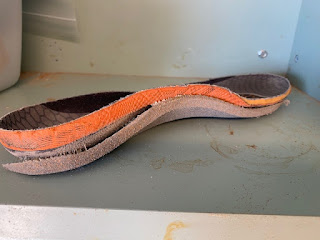1/4 inch varus wedges applied to several OTC insert
A closer look at the varus wedge applied along the medial aspect of the insert
Pronation is a normal function of the foot (with a similar motion described for the wrist). The foot pronates as you hit the ground creating good motion to absorb shock, and loosening the foot to adapt to the ground. Therefore, pronation is a normal and necessary function for the body.
I just ran a workshop to 6 students at the California School of Podiatric Medicine at Samuel Merritt University. Two of these students were what you call excessive pronation where the motion of pronation lead to significant arch collapse and knee instability. One of these had the instability limited to the lower extremities. But, the other student also had trouble with his hips and back where the foot pronation destabilized the entire body.
Therefore, if the pronation motion is too much, too prolonged in gait, or too rapid to decelerate, symptoms can occur from the foot up. Since there are over 20 symptoms tied to the pronation syndrome, patients tend to pick on their individual weak spots. One excessive pronator can present with posterior tibial tendonitis, another plantar fasciitis, another knee or hip pain, up to the spine and upper extremities.
What does this have to do with varus wedges? A 1/4 inch varus wedge makes a typical 4 degree change in the pronation for a patient. The varus wedge can be just a heel wedge, but will not help as much for a runner when they go up on the ball of their feet.
Athletes in general are in my office complaining about their knee, ankle or foot. But, I like to talk to them about other problems they have to either a lesser degree, or significant past problems. They may have had serious bouts of plantar fasciitis, shin splints, achilles, etc, but just not now.
One of my patients presented with posterior tibial problems and was very pronated. OTC arch supports and one pair of custom orthotic devices in the past were either painful to wear or did not fit into her shoes well. We spent some time over the next year designing comfortable but stabilizing orthotic devices. Over the next year I remember her counting over 10 areas in her body, mainly lower extremity, that did not hurt anymore (they were all part of this pronation syndrome).
Therefore, if you have some symptoms, or if your patients have symptoms, that you think could be tied to this syndrome of over pronation, applied a varus wedge as small as a varus wedge to one pair of shoes and see if the symptoms improve. It could be as vital as an MRI.
In the next few days, I will do a video to show how you can use an old shoe insert, cut the medial one inch off, apply it to another full insert to create a varus wedge. I sure hope this helps. Rich


Hi Dr. Blake,
ReplyDeleteWhat material do you use for varus wedging?
thanks, Michele
Michele, I use a cork and rubber composite from JMS plastic from New Jersey. It is either called Rubber Cork or grinding cork? You will be able to tell on their website. Really anything that can be beveled can be used! Ruch
ReplyDeleteHave you posted the video?
ReplyDeleteGreat article!